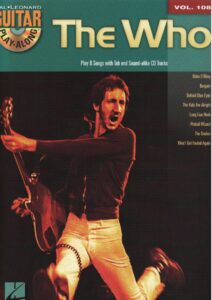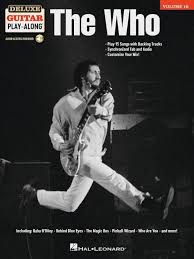Come join us now, and enjoy playing your beloved music and browse through great scores of every level and styles!
Can’t find the songbook you’re looking for? Please, email us at: sheetmusiclibrarypdf@gmail.com We’d like to help you!
Table of Contents
On this day in 1975, “The Who” released the album “The Who by Numbers”
On The Numbers: The Who’s Raw, Unflinching Portrait of Mid-Life Crisis
On October 3, 1975, the landscape of rock music was not shaken by a revolutionary new sound, nor was it shattered by a work of grand operatic ambition. Instead, it was quietly, brutally, confronted with a moment of stark introspection. On this day, The Who—a band synonymous with explosive power, youthful rebellion, and epic narratives—released “The Who by Numbers,” an album that stood in direct contrast to its predecessors. It was not a triumphant roar, but a weary, honest, and deeply personal confession.
To understand the seismic shift of “The Who by Numbers,” one must first appreciate the colossal stature The Who had achieved by the mid-1970s.

Best Sheet Music download from our Library.
The Who: A Colossal Force
Formed in London in 1964, The Who comprised four distinct, volatile, and brilliantly talented individuals:
- Pete Townshend (Guitar, Vocals, Primary Songwriter): The intellectual and creative engine, a visionary who pushed the boundaries of rock into concept albums and rock opera.
- Roger Daltrey (Lead Vocals): The quintessential frontman, whose powerful voice and commanding stage presence gave Townshend’s songs their swagger and heart.
- John Entwistle (Bass Guitar, Vocals, Horns): “The Ox,” a virtuoso bassist whose complex, melodic lines formed the band’s intricate foundation and whose thunderous sound was a force of nature.
- Keith Moon (Drums): “Moon the Loon,” a percussive hurricane of energy and chaos, whose unpredictable, fill-heavy style was the band’s explosive core.

Please, subscribe to our Library.
If you are already a subscriber, please, check our NEW SCORES’ page every month for new sheet music. THANK YOU!
Their early years were defined by Mod anthems of teenage angst and fashion, encapsulated in the explosive “My Generation” with its iconic line, “Hope I die before I get old.” They were the sound of amp-stacking, guitar-smashing rebellion.
As the 60s progressed, Townshend’s ambitions grew. The 1969 rock opera “Tommy” catapulted them to global superstardom, transforming them from a hit-making band into artistic heavyweights. This was followed by the sprawling, introspective “Who’s Next” (1971), crafted from the ashes of another failed concept, “Lifehouse.” With anthems like “Baba O’Riley” and “Won’t Get Fooled Again,” it fused rock power with nascent synthesizers, creating a timeless masterpiece. By 1973’s “Quadrophenia,” another complex double-album opera, The Who were at their artistic and commercial peak, but the cracks were beginning to show.

Contents List Download:
Browse in the Library:
Or browse in the categories menus & download the Library Catalog PDF:
The Context: A Band Under Strain
By 1975, the weight of a decade of touring, recording, and internal strife was crushing.
- Townshend’s Crisis: Plagued by alcoholism, self-doubt, and a feeling of creative exhaustion, Townshend was struggling with his role as the “voice of a generation.” He was turning 30, and the themes of teenage rebellion that once defined him now felt hollow.
- Band Tensions: The members were growing apart. Keith Moon’s legendary antics were taking a severe physical toll, and his drumming, while still powerful, was becoming less reliable. John Entwistle, feeling underutilized, was growing increasingly disgruntled. Roger Daltrey had matured into a formidable bandleader, often clashing with Townshend over the band’s direction.
- The End of an Era: The mid-70s marked the end of the initial rock and roll explosion. Punk was stirring, and the grandiose stadium rock of bands like The Who was soon to be challenged.
It was from this cauldron of anxiety, burnout, and disillusionment that “The Who by Numbers” emerged.
“The Who by Numbers”: A Track-by-Track Descent
Produced by the band’s long-time collaborator Glyn Johns, the album’s sound is more stripped-down and acoustic-based than the synth-driven “Who’s Next” or the orchestral sweep of “Quadrophenia.” It’s a raw, direct, and often acoustic-led record, putting Townshend’s confessional lyrics front and center.
- “Slip Kid” – The album opens with a deceptive burst of energy. A driving, powerful rocker, it seems like classic Who. But the lyrics immediately set the tone: “There’s no easy way to be free.” It’s a song about disillusionment, a warning that the dreams sold to the youth are a lie.
- “However Much I Booze” – This is the album’s brutal, unvarnished heart. A solo acoustic track from Townshend, it is a devastatingly honest admission of his alcoholism and the helplessness he felt. The line, “The kids on the street are all right, but however much I booze, there’s still no release,” is a stark contrast to the man who once wrote an anthem for “the kids.”
- “Squeeze Box” – The album’s sole hit single, a lighthearted, double-entendre-driven romp with a prominent banjo. It provided a moment of levity, but in the context of the album, it feels almost like a desperate attempt to cling to the hit-making formula.
- “Dreaming from the Waist” – Another rocker about impotence, both creative and sexual. It reflects Townshend’s feeling of being past his prime, of having lost the fiery inspiration of youth.
- “Imagine a Man” – A beautiful, melancholic ballad that showcases Townshend’s more philosophical side. It’s a quiet moment of reflection on the mundane struggles of life, far removed from the epic themes of “Tommy.”
- “Success Story” – Written and sung by John Entwistle, this cynical rocker perfectly captures the band’s jaded view of stardom. With lyrics about “another album, another tour,” it’s a biting satire of the rock and roll machine they were trapped in.
- “They Are All in Love” – A wistful, string-laden song that feels like a farewell to the band’s audience and their own youth. The line “They are all in love, I’m just stuck here dreaming” underscores a feeling of being left behind.
- “Blue, Red and Grey” – Perhaps the most vulnerable song The Who ever recorded. It’s just Townshend with a ukulele and a muted brass band, singing about appreciating the small, quiet moments of the day. It’s a world away from “Baba O’Riley”‘s synthesizer gales.
- “How Many Friends” – A poignant exploration of paranoia and loneliness, questioning the authenticity of the people around him. “How many friends have I really got?” Daltrey sings, giving voice to Townshend’s deep-seated insecurities.
- “In a Hand or a Face” – The album closes on a burst of frantic, almost desperate energy, but the lyrics remain cryptic and disillusioned, ending the record on an unresolved, questioning note.
Legacy and Impact
“The Who by Numbers” was a commercial success, reaching No. 7 in the UK and No. 8 in the US, proving the band’s fanbase would follow them into darker territory. However, critically, it was divisive. Some praised its raw honesty, while others missed the grand statements and anthemic power.
Over time, its reputation has grown significantly. It is now seen as a crucial, if uncomfortable, chapter in The Who’s story—a “survival album.” It wasn’t about changing the world; it was about the band, and particularly Townshend, trying to save themselves. It is one of rock’s most unflinching documents of mid-life crisis, a record that dared to ask, “What happens after you survive your youth?”
The album’s cover, a comic strip by cartoonist Ron Wood (later of The Rolling Stones) showing the band members being assembled and disassembled, perfectly encapsulates its theme: the deconstruction of a rock giant.
The Who would continue, of course, facing even greater tragedy with the death of Keith Moon in 1978. But they would never again make an album so purely, painfully confessional. “The Who by Numbers” remains a testament to the fact that sometimes the most courageous act for a rock band is not to smash their instruments, but to look in the mirror and document the cracks they see.
The Who – The Who By Numbers – (A1-A4)
The Who – The Who By Numbers – (A1-A4) Recorded: April – June 12, 1975 Studio: Shepperton Studios’ soundstage (Shepperton, Surrey, England) using Ronnie Lane’s Mobile Studio Producer: Glyn Johns
Released: October 3, 1975 Label: MCA Records Format: Vinyl, LP, Album Country: UK Genre: Rock
| Track List: |
| 1 | Slip Kid | 4:30 | |
| 2 | However Much I Booze | 5:02 | |
| 3 | Squeeze Box | 2:41 | |
| 4 | Dreaming From The Waist | 4:07 | |
| 5 | Imagine A Man | 4:00 | |
| 6 | Success Story | 3:20 | |
| 7 | They Are All In LovePiano – Nicky Hopkins |
| 8 | Blue Red And Grey | 2:47 | |
| 9 | How Many Friends | 4:05 | |
| 10 | In A Hand Or A Face | 3:23 | |
| 11 | Squeeze Box (Live) | 3:11 | |
| 12 | Behind Blue Eyes (Live) | 3:37 | |
| 13 | Dreaming From The Waist (Live) |
Browse in the Library:
Or browse in the categories menus & download the Library Catalog PDF:
